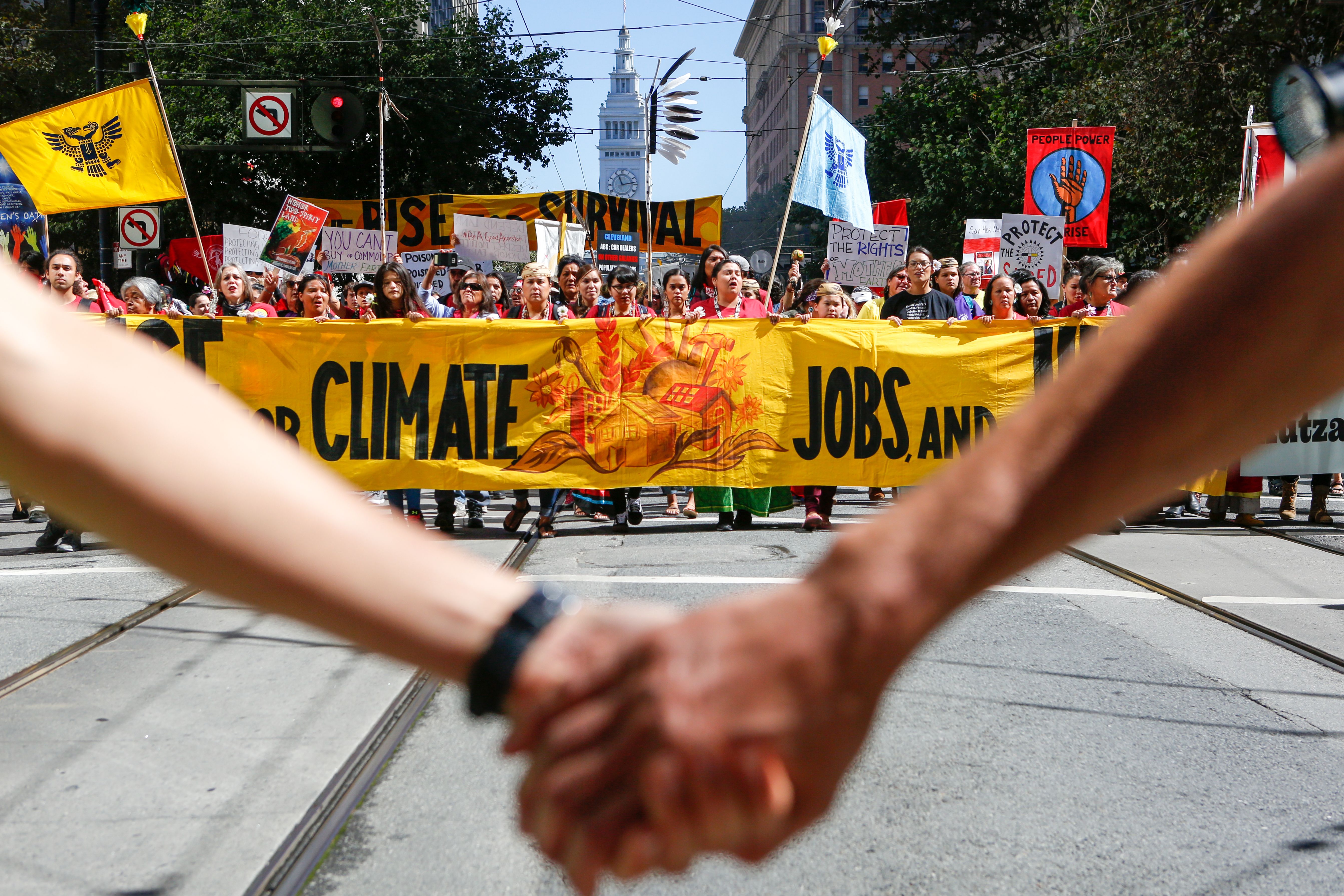
(Photo: Amy Osborne/AFP/Getty Images)
One October morning in 2017, Bronte Edwards awoke in the predawn hours to a flurry of missed calls, voicemails, and texts. The Tubbs Fire was consuming her hometown of Santa Rosa, California, and her family had been evacuated. They’d had just half an hour to pack up their things.
Edwards returned to see her homeplace burned in patches, with blocks of scorched chimneys and metal staircases standing alongside a house or two that survived. Though her own house and family were among those still standing, the threat of destruction never went away.
This is not the Santa Rosa where Edwards grew up. California wildfires have become bigger and more destructive recently, part of an uptick in extreme weather events that scientists attribute to global warming. Of the state’s 10 most destructive fires, five have occurred in the last four years, and the Tubbs Fire that hit Santa Rosa was the most destructive in state history, burning through 36,810 acres and killing 22 people. The state’s most recent climate change assessment found that residents can expect to see 77 percent more land burned by the end of the century.
Edwards started doing her own research, reviewing data from the state-run website CAL Fire and what she found radicalized her: a marked increase in acres burned by wildfires in California in recent decades. That’s consistent with a study out of the National Academy of Sciences estimating that the acreage burned across forests in the western United States between 1984 and 2015 has doubled owing to human-caused climate change. Since then, the fires have only gotten bigger.
When she heard about the Rise for Climate Jobs and Justice mobilization ahead of the Global Climate Action Summit in San Francisco, Edwards not only resolved to march as part of a contingent of activists already being affected by climate change; she also began passing out flyers and talking the march up to classmates at Santa Rosa Junior College, where she goes to school.
“I’m trying to get people do something like ‘#SonomaStrong,’ or ‘Citizens of Sonoma County,’ or ‘Survivors of the Fire—We Care About Climate Change,'” she told me of her desired messaging ahead of the march. “We’re the ones on the front lines taking the risk because of where we live,” she said. “It’s already too late, in my opinion.”

Last year, an unseasonable snow storm pummeled an international summit of mayors gathered to fight climate change in New York. This year, many of those same mayors are convening in San Francisco amid a spate of the worst wildfires in the state’s history.
Mayor Muriel Bowser of Washington, D.C., who missed the 2017 summit to handle storm fallout, told me that the freak snow was “a reminder to us all that our Earth is changing.”
This year, no one needs the reminder.
The GCAS is meant to spotlight local leaders from around the world who are working to deliver climate progress in the face of federal intransigence and opposition. Its headline event, to be held Wednesday at San Francisco’s City Hall, has what’s meant to be an uplifting tagline, emphasizing our collective agency in fixing the crisis: “The Future Is Us.”
In 2018, in the San Francisco Bay Area, that message takes on a darker tone.
It’s coming from a state that just suffered its largest wildfire in history amid yet another year of record-breaking fires. And it’s coming at a time when sea level rise is accelerating: A recent report suggests as much as 165 square miles of coast land could be underwater by 2100, including much of the San Francisco airport.
The water is coming, that much is clear. The question is how much.
“There is no permanent solution to this problem,” Manoochehr Shirzaei, an Arizona State University geophysicist and lead author on the report, told Wired earlier this year. “This will impact us one way or another. The forces are immense, it’s a very powerful process, the cost of really dealing with it is huge, and it requires long-term planning. I’m not so sure there’s a good way to avoid it.”
“Yeah,” I think, “The future really is us in California.” It’s also already here.
Recent polling from the independent Public Policy Institute of California shows that a strong majority of Californians—and three-quarters of Bay Area residents—agree. Specifically, a majority of Californians believe that the effects of global warming have already begun; nearly nine in 10 Californians (87 percent) acknowledge that those effects are coming.

It used to be that mayors and their climate plans were just a quirky sideshow to the main events of U.S. environmental diplomacy. At the Paris climate talks in 2015, the closest equivalent to the GCAS felt sort of like an Academy Awards ceremony for goofy policy nerds, with mayors cheerfully accepting honors for their climate-friendly projects.
But that was when Barack Obama was president. Under President Donald Trump, local leaders are suddenly all America has left to offer for climate action.
And this year’s event for cities—hosted by C40 Cities, the same global coalition that hosted the event in Paris, as well as by The Global Covenant of Mayors for Climate and Energy and the City of San Francisco—will feature less levity and much more substance.
Instead of being a sideshow, “Cities4Climate: The Future Is Us” will kick off the GCAS in San Francisco, an invitation-only conference aimed at top climate influencers from around the world intent on accelerating climate action, even as federal efforts fall short.

(Photo: Amy Osborne/AFP/Getty Images)
California Governor Jerry Brown began planning the conference after Trump pulled the U.S. out of the Paris Agreement. And Wednesday’s kick-off will feature such international climate stars as Christiana Figueres and Laurence Tubiana, executive secretary and special envoy for the United Nations Framework Convention on Climate Change at the Paris talks, respectively, as well as former Vice President Al Gore.
Brown has made climate change his signature issue, signing ambitious legislation to curb emissions—benchmarks that the state is already outpacing—and upstaging the president on climate internationally. Critics on the left decry his continued expansion of oil drilling in the state and refusal to ban fracking. Still, California has distinguished itself as the country’s unequivocal leader on climate (so much so that it’s become a cliché to say as much) and is easily on track to get 50 percent of its electricity from renewable resources by 2030.
Last month, state lawmakers went further, passing legislation to move the 2030 target to 60 percent renewables and requiring that 100 percent of electricity come from carbon-free sources by 2045, in what amounts to the most aggressive bill of its kind in the nation. On Monday, Brown signed the legislation into law. Coming in the final months of Brown’s last term, the summit will be, among other (more important) things, his political swan song.
Meanwhile Gore, having failed to influence the president through Trump’s daughter Ivanka, has pinned his hopes on something more achievable: city, state and regional climate action. “I did worry that other nations would follow Trump’s lead and use his decision as an excuse for them to pull out themselves, but none of them did.” Gore told Pacific Standard‘s Kate Wheeling at his Los Angeles-based summit for local leaders last month. “And to the contrary, so many states, including California, have stepped up.”
One might think that Californians would be patting themselves on the back right now: Their economy is booming as emissions continue to drop, and the state’s leadership has effectively displaced the White House as the Americans who are actually taken seriously on the international climate stage.
But climate change doesn’t respect state boundaries, and ongoing struggles with drought and wildfires show that Californians are already suffering the consequence of everyone’s neglect.
Local actors can’t make up for a checked-out federal government, but they can minimize damage until power changes hands. “It’s up to you and it’s up to me and tens of millions of other people to get it together to roll back the forces of carbonization,” Brown tells potential summit attendees in a welcome video. “We need people who represent the whole world because this is about the whole world and the people who live here.”
Coming ahead of COP24 in Katowice, Poland, this December, the GCAS will also serve as a tool for international reassurance at a time when that’s very much in need. “Donald Trump may have pulled out of the Paris Agreement, but the American people are staying in it,” former Secretary of State John Kerry said recently. Kerry added that he had been able to reassure European allies about American climate commitments by pointing to state and local action in the U.S.
It also doesn’t hurt that the mid-term elections are right around the corner.
On Friday, Obama’s speech at the University of Illinois highlighted how radically fringe Trump’s Paris withdrawal is to the rest of the world. “The only nation on Earth to pull out of the global climate agreement—it’s not North Korea, it’s not Syria, it’s not Russia or Saudi Arabia—it’s us,” Obama said. “We know that climate change isn’t just coming; it’s here.”
That was the rallying cry of the hundreds of advocacy groups that joined forces over the weekend in the “Rise for Climate, Jobs and Justice” mobilization, holding demonstrations in dozens of cities across the world, including the flagship march in San Francisco. Organizers of those mobilizations were clear that they wanted to help amp up urgency at the GCAS (while also condemning Trump). But they’re also appealing to the immediacy of the problem.
“We’re definitely talking about the direct impacts of climate,” Sierra Club’s Resist Campaign Director Maura Cowley says, adding a hopeful note: “There’s a way we emerge from this crisis that is actually good for cities and states, and good for the country.”
It starts with marchers like Edwards, whose experience, and subsequent research into how climate change fuels California’s wildfires, turned her into an activist.
“A lot of the folks here,” she says, “are still completely traumatized. People a year later are still kind of having these flashbacks.”
Recently, when Edwards turned on the heat for the first time in months, her mother—startled by the unfamiliar smell of the toasted air—came running down the stairs in the middle of the night. “What’s going on? What’s on fire? What’s going on?” she cried. It was just a bit of dust in the ducts, Edwards told her, adding, “I was cold.”
And Edwards recalls certain details vividly, like how the Tubbs fireline came right up to the edge of her aunt’s house, or how even after the flames were squelched, the ground was still smoking.
“It was like something out of an apocalyptic movie,” she says.
Only it wasn’t a movie, of course—it was her apocalyptic reality. This was her climate, changed before her eyes.




